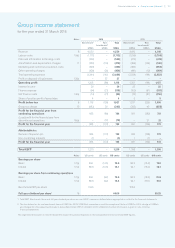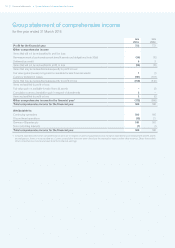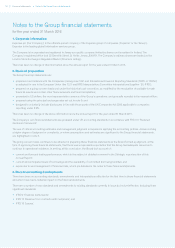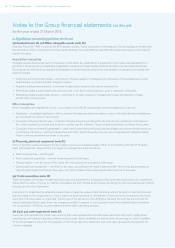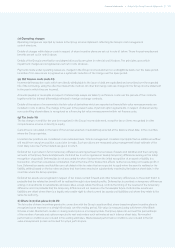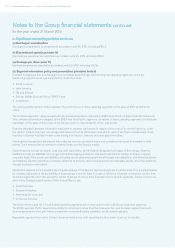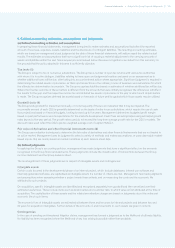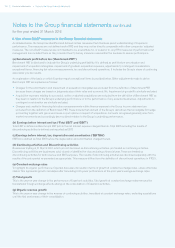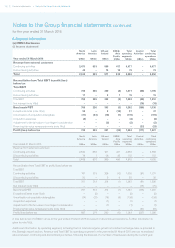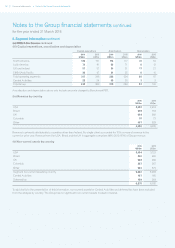Experian 2016 Annual Report Download - page 124
Download and view the complete annual report
Please find page 124 of the 2016 Experian annual report below. You can navigate through the pages in the report by either clicking on the pages listed below, or by using the keyword search tool below to find specific information within the annual report.
122
Notes to the Group financial statements continued
for the year ended 31 March 2016
Financial statements •Notes to the Group nancial statements
4. Significant accounting policies continued
(l) Post-employment benefit assets and obligations (note 32)
Defined benefit pension arrangements – funded plans
The post-employment benefit assets and obligations recognised in the Group balance sheet in respect of funded plans comprise
the fair value of plan assets of funded plans less the present value of the related defined benefit obligation at that date. The defined
benefit obligation is calculated annually by independent qualified actuaries, using the projected unit credit method. Under this
method, and in view of the fact that the principal Experian funded plan is closed to new entrants, the current service cost increases
as members approach retirement, due to the plan’s ageing active membership.
The present value of the defined benefit obligation is determined by discounting the estimated future cash outflows, using market
yields on high-quality corporate sterling bonds with maturity terms consistent with the estimated average term of the related
pension liability.
Defined benefit pension arrangements – unfunded plans
Unfunded pension obligations are determined and accounted for in accordance with the principles used in respect of the
funded arrangements.
Defined contribution pension arrangements
The assets of defined contribution plans are held separately in independently administered funds. The pension cost recognised in
the Group income statement represents the contributions payable by the Group to these funds, in respect of the year.
Post-retirement healthcare obligations
Obligations in respect of post-retirement healthcare plans are calculated annually by independent qualified actuaries, using an
actuarial methodology similar to that for the funded defined benefit pension arrangements. The cost recognised in the Group
income statement only comprises interest on the obligation.
(m) Own shares (note 36)
The Group has a number of equity-settled, share-based employee incentive plans. In connection with these, shares in the Company
are held by the Experian plc Employee Share Trust and the Experian UK Approved All-Employee Share Plan. The assets of these
entities mainly comprise Experian shares, which are shown as a deduction from total equity at cost.
Shares in the Company purchased and held as treasury shares, in connection with the above plans and any share purchase
programme, are also shown as a deduction from total equity at cost. The par value of shares in the Company that are purchased
and cancelled, in connection with any share purchase programme, is accounted for as a reduction in called up share capital with
any cost in excess of that amount being deducted from retained earnings.
(n) Revenue recognition (note 8)
Revenue represents the fair value of consideration receivable on the provision of services, net of any sales taxes, rebates and
discounts. Revenue includes the provision and processing of data, subscriptions to services, software and database customisation
and development, and the sale of software licences, maintenance and related consulting services.
Revenue in respect of the provision and processing of data is recognised in the period in which the service is provided. Subscription
revenues, and revenues in respect of services to be provided by an indeterminate number of acts over a specified period of time,
are recognised on a straight-line basis over those periods. Customisation, development and consulting revenues are recognised
by reference to the stage of completion of the work, which is generally on the basis of costs incurred to date as a percentage of
estimated total costs. Revenue from software licences is recognised upon delivery. Revenue from maintenance agreements is
recognised on a straight-line basis over the term of the maintenance period.
Where a single arrangement comprises a number of elements which are capable of operating independently of one another, the
total revenues are allocated amongst the elements, based on an estimate of the fair value of each element. Where the elements are
not capable of operating independently, or reasonable measures of fair value for each element are not available, total revenues are
recognised on a straight-line basis over the contract period, to reflect the timing of services performed.
Sales are generally invoiced in the geographic area in which the customer is located. As a result, the geographic location of the
invoicing undertaking is used to attribute revenue to individual countries.



